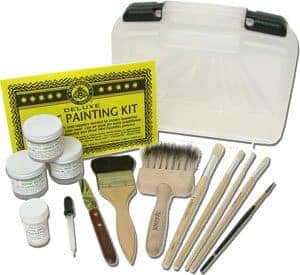Painting on sandblasted Glass
If I do glass painting on frosted or sandblasted glass, will there still be a tin residue that I need to avoid?
Thanks! Laurinda
Milly’s reply: Thanks for your question Laurinda. The good news is that the answer is ‘no’, the sandblasting removes the all-but-invisible coating on the tinned side, so you won’t have to bother with trying to identify it in this case. Anything that makes painting easier is good in my book!
Firing Two Layers Of Paint
I loved your site. I’ve been working with glass since 1982. Another way to get more than one layer of glass paint on before firing is to use slightly heavier gum arabic and water on one layer and grain alcohol and NO gum arabic on the second. The second coat comes off very easily, so be careful. This way you can put on two coats of shading before firing.Leigh
Milly’s reply:
Thanks for this, Leigh. It’s really helpful. I’ve never used gum arabic and alcohol as a way of combining firings before – good idea!
I have mixed the first layer of glass paint with Damar varnish and distilled turpentine, let it dry before adding another blended coat with a badger – this time using paint mixed with water. That avoids a second firing too. Any more painting tips out there?
Is it OK to mix silver stain with vinegar?
For my project I need to stain a piece of glass. Most websites come up with painting on glass, but I just want to do the yellow staining.
I did this at school, but I remember mixing the silver stain with a little vinegar and I think a bit of water. Would you know how to do this? Christine
Milly’s answer:
I’ve only ever mixed silver stain (also called silver nitrate) with water.
The vinegar technique is used to enable you to paint one layer of glass enamel over another, so that you can fire two layers at once – something you don’t need to do when using silver stain.
I do have a silver stain page – have a look at: Stain Glass under the ‘Techniques’ section for more detailed information. Hope that helps.
Enamels for Bullseye Glass
I am experimenting by screen printing onglaze enamels and then firing the glass. Is there any enamels you can recommend that can withstand high firing temperatures and have a CoE for working with Bullseye glass?
Milly’s answer:
This is a very good question, given the complexity of glass compatibility issues.
The good news is that there’s no compatibility issues with onglaze enamels, as long as they are applied thinly. Screenprinting is perfect – you can’t get thinner than that!
To explain further: the term ‘enamel’ is a broad term, and covers two types of glass paint:
1. The type you’re working with, which are a mixture of powdered clear glass and highly coloured oxides (eg Ferro, Heraeus)
2. Powdered frits that are simply crushed coloured glass ground down to powder form. (eg Bullseye, Thompson and Schott Artista)
Because type 1. includes intensely coloured oxides, you don’t need a thick layer to get good results – especially with opaque onglaze enamels – and so, thinly applied, this type of enamel is compatible with any glass.
With regards to temperature, type 1. enamels are either low or high-firing – ask the manufacturer which range to choose from. The high-firing ones are nearly always opaque, although the blues can be transparent if fired thinly enough. I use Ferro – their Sunshine Series is high firing – and Heraeus. Reusche are supposed to manufacture high firing transparents, but I haven’t tried them.
Last thought: transparent enamels contain lead and should be used with care.
I hope that answers your questions.
This painting starter kit is available on Amazon
This painting starter kit is available on Amazon Peter Mcgrain Deluxe Paint Starter Kit


